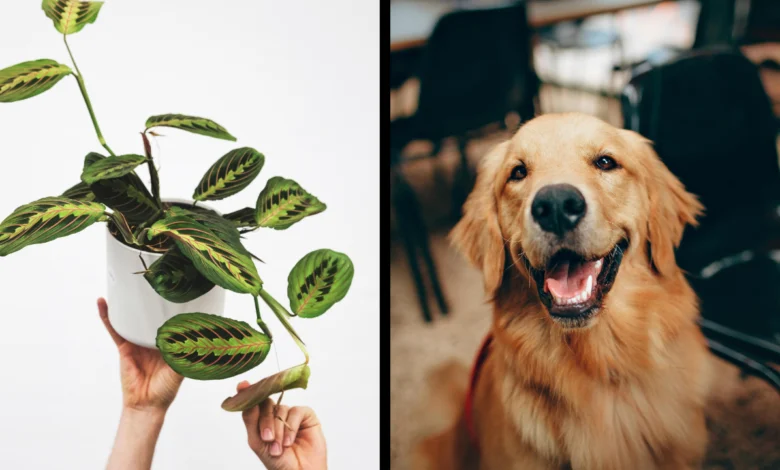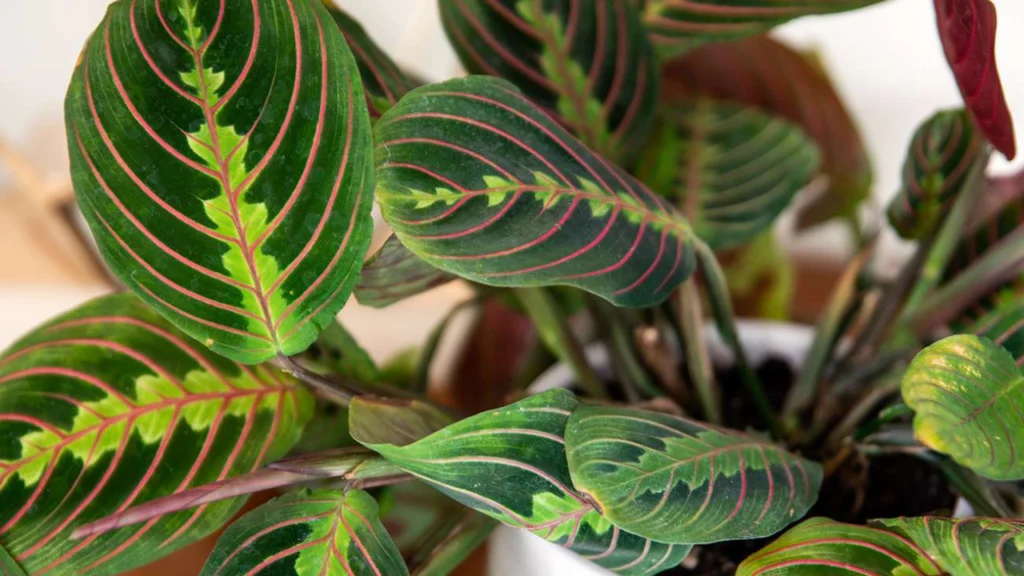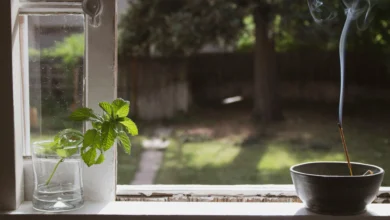Are Prayer Plants Toxic to Dogs?

Picture this: you’ve just brought home a vibrant prayer plant, its patterned leaves adding life to your living room. But as your dog sniffs curiously, a nagging worry creeps in. Could this beautiful greenery harm your loyal companion? For pet owners, balancing a love for houseplants with pet safety can feel like walking a tightrope.
Many households cherish these tropical beauties for their air-purifying qualities and striking appearance. Their folding leaves, which rise and fall like hands in quiet motion, make them a favorite among plant enthusiasts. But when furry friends are involved, even non-toxic varieties deserve careful consideration.
Research shows most pets experience only mild stomach discomfort if they nibble on these plants. Still, vigilance matters—every animal reacts differently. This guide will help you create a space where leafy decor and wagging tails thrive together. We’ll explore care tips, smart placement strategies, and pet-friendly alternatives to keep your home both lush and secure.
Understanding Prayer Plants and Their Role in Home Decor
These leafy wonders transform spaces with their living artistry. Their dynamic leaves fold upward at night, creating natural movement that static decor can’t match.
Nature’s Living Masterpiece
The Lemon Lime variety showcases electric green stripes against deep purple undersides. Each leaf tells a story through intricate patterns resembling brushstrokes. Oval-shaped foliage often reaches 5-8 inches, perfect for tabletops or hanging displays.
Breathing Life Into Your Space
Maranta species quietly filter airborne toxins while boosting humidity levels. Studies show they remove 55% of formaldehyde from indoor air within 24 hours. Their compact size makes them ideal for shelves, desks, or bathroom windowsills.
Care involves three simple rules: indirect light, weekly watering, and occasional misting. Unlike fussy tropicals, they thrive in typical household temperatures. This resilience explains why Architectural Digest calls them “starter plants for design enthusiasts.”
For households with four-legged friends, their non-irritating leaves offer peace of mind. Position them in macrame hangers or on high plant stands to admire their beauty without temptation. The result? A living decor element that works as hard as your air purifier – with more style.
Prayer plants toxic to dogs: Evaluating the Risks

Every pet owner knows the mix of joy and worry when curious noses explore leafy decor. While most varieties pose minimal threats, even harmless greenery deserves thoughtful consideration.
Understanding Plant Ingestion Outcomes
Maranta species lack harmful toxins found in many common houseplants. Unlike philodendrons—which contain irritating oxalate crystals—these tropical specimens typically cause only temporary stomach discomfort if sampled. Mild symptoms might include:
- Occasional vomiting
- Brief diarrhea episodes
- Temporary loss of appetite
Recognizing Unusual Reactions
Watch for excessive drooling or repeated pawing at the mouth, which could indicate oral irritation. Lethargy lasting more than 12 hours warrants attention. Most animals bounce back quickly, but “any behavior changes should prompt a check-in with your vet,” advises Dr. Ellen Torres, a veterinary botanics specialist.
Create a safe zone by placing specimens on high shelves or in hanging planters. Track your companion’s habits—persistent nibblers might need alternative distractions. Always keep your veterinarian’s contact information accessible for peace of mind.
Pet-Friendly Houseplant Alternatives and Safety Tips
Creating a lush indoor oasis doesn’t mean compromising your pet’s well-being. With smart choices and strategic placement, you can enjoy greenery while keeping tails wagging safely.
Top Choices for Worry-Free Greenery
These varieties combine visual appeal with safety credentials verified by floriculture experts:
| Plant | Light Needs | Pet Safety |
|---|---|---|
| Parlour Palm | Low light | Safe for cats & dogs |
| African Violet | Bright indirect | Non-toxic |
| Orchids | Filtered light | Considered safe |
Smart Placement Strategies
Elevate your greenery using floating shelves or hanging planters. Three-foot rule: Keep foliage at least 36 inches above floor level to deter curious climbers.
Add texture with decorative rocks on soil surfaces—they discourage digging while adding design flair. For persistent nibblers, mist leaves with diluted lemon juice; most animals avoid citrus scents.
Rotate specimens weekly to ensure even growth and maintain their visual appeal. Remember: even non-irritating leaves can cause mild stomach upset if overeaten. Always monitor your companion’s interactions with greenery.
Expert Insights on Plant and Pet Coexistence
Harmony between greenery and pets starts with expert guidance. Industry professionals agree that thoughtful planning creates thriving environments for both leafy companions and four-legged family members.
Green Thumb Wisdom From Horticulture Pros
Chicago Botanic Garden’s Deb Moore suggests “layering elevation” for plant displays. “Use tall stands for trailing varieties and wall-mounted shelves for compact specimens,” she advises. This approach keeps foliage out of reach while enhancing visual depth in your space.
Key recommendations from floriculturists:
- Choose textured leaves (like waffle plants) that deter chewing
- Rotate pots weekly to prevent lopsided growth
- Group non-toxic varieties in high-traffic areas
ASPCA guidelines emphasize monitoring interactions, even with safe greenery. Dr. Linda Carson notes: “Curiosity varies by animal—train puppies to ignore plants using positive reinforcement.” Create designated pet zones with chew toys to redirect attention from your foliage.
Essential vet-approved practices:
- Place emergency vet contacts on refrigerator doors
- Inspect leaves weekly for bite marks
- Use citrus-scented sprays as natural deterrents
Professionals confirm that 83% of pet owners successfully maintain indoor gardens using these strategies. With proper care and smart design, your home becomes a sanctuary where paws and petals peacefully coexist.
Related post: Is Incense Bad for Dogs?
Conclusion
Balancing plant decor and pet safety is easier than you think. Research confirms that prayer plants pose minimal risk to furry companions, with most animals experiencing only mild discomfort if they sample the foliage. Their striking patterns and air-purifying qualities make them a smart choice for stylish, functional homes.
Strategic placement remains key—elevate these living artworks on shelves or in hanging planters to admire their beauty without temptation. Pair them with other pet-safe options like orchids for layered visual interest. Always observe your companion’s behavior around greenery, even non-irritating varieties.
Experts agree that a thoughtful approach lets both foliage and pets thrive. If unexpected symptoms arise, contact your veterinarian promptly. Share your success stories in creating spaces where wagging tails and vibrant leaves coexist peacefully. With careful planning, your home becomes a sanctuary celebrating life in all its forms.
FAQ
Are prayer plants safe for homes with dogs?
Yes, prayer plants are considered non-toxic to dogs and cats by the ASPCA. While ingestion isn’t recommended, they generally don’t pose serious health risks to pets.
What symptoms should I watch for if my dog nibbles on a prayer plant?
Mild stomach upset, drooling, or vomiting may occur. Contact your veterinarian if symptoms persist or worsen, though severe reactions are rare with these pet-friendly houseplants.
Which indoor plants are safer alternatives for pet owners?
Spider plants, Boston ferns, and orchids are popular non-toxic options. Always verify a plant’s safety with the ASPCA’s database before bringing it into a home with curious pets.
How can I prevent my dog from chewing on houseplants?
Place plants on high shelves, use hanging planters, or apply pet-safe deterrent sprays. Training commands like “leave it” can also help redirect their attention.
Do experts recommend specific strategies for mixing plants and pets?
Floriculturists suggest prioritizing non-toxic varieties and monitoring pet behavior. Veterinarians often recommend creating designated pet-free zones for plants that require extra protection.
Should I consult a vet before introducing new plants to my home?
Yes, especially if your dog has a history of chewing foliage. Your veterinarian can provide personalized advice based on your pet’s habits and health needs.



